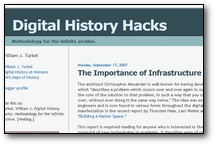Bill Turkel posted another great thought piece today on the Importance of Infrastructure. This post is, as his others always are, very erudite, well phrased and provoke one to think. In this case, his framing question  seems to be whether one can really environmentally engineer innovation. His post suggests that letting the right people play in the right sandbox, with the right toys can yield astonishing results. He addresses the nature of how we construct personal space in order to bolster productivity, creativity and all those good things.
seems to be whether one can really environmentally engineer innovation. His post suggests that letting the right people play in the right sandbox, with the right toys can yield astonishing results. He addresses the nature of how we construct personal space in order to bolster productivity, creativity and all those good things.
Ironically, I just finished browsing past an RSS feeds suggesting the close connection between clutter and depression. Turkel’s article is a raises the question of surroundings to a higher level though. He invokes Christopher Alexander, the guru of environmental design reasoning, and concludes that "the right infrastructure attracts the right people and then something really cool happens. But it isn’t possible to predict in more detail than that." Thus, the Alexander principle of taking patterns and iteratively exploding patterns into smaller patterns, stops at some level of granularity. The challenge that he identifies is that creation of theses spaces often demands some prediction of the outcome to capture the appropriate resources.
One thing that struck me about this discussion was that my physical environment is very heavily dependent upon and increasingly augmented today by a virtual environment. Moreover, many of the folk trying to use patterns to create the best work environment have to be aware of these ties to the virtual worlds when creating the physical sandbox. Moreover, there is an intriguing connection between how one translates the ideal real world environment into a compelling and useful online existence. There’s a necessary translation between the physical and the virtual, but there is a clear connection, that if we can better appreciate, might also catalyze results.
The second arise from the fact that I am one of those that Turkel identifies as finding the coffee shop the most appropriate environment for work. I blogged on this earlier and attempted to get to this concept of the technologically augmented workspace in a public place. When I started using coffee shops to work in I was still drawn back to the home office for things like net access and other wired media. Increasingly what I can do in a public space has become more pervasive. This however has changed the nature of the cafe environment itself. Inadvertently it was a refuge from the net – now it is invaded by the net and it takes discipline to tear oneself away. Everything is fluid and workspaces have to be too.
I recall when we were working with a designer on our space for Ardesic, we were attempting to create an adaptable and accidental space that people were able to turn into one that suited their needs and the needs of the company. We tried to provide versatile function with whiteboards on odd surfaces and whiteboards on wheels and walls that moved and desk areas based on a metaphorical hug. None of this really worked. I test drove furniture at Herman Miller’s luscious showroom in Toronto and came away convinced that much of this stuff would work, but when it was translated into another space and tried to fulfill others demand, there was a mixed bag of success and absolute failure. Ultimately, although we recognize the need for personal and personalized space, its tough to harmonize this with semi-public space.
I guess I am starting to stray from Bill’s point about infrastructure before innovation, but decided that a tangent about the translation between the physical and the virtual environment is worth consider, given that project infrastructures are increasingly trying to blend the physical with the virtual to reach their objectives.
